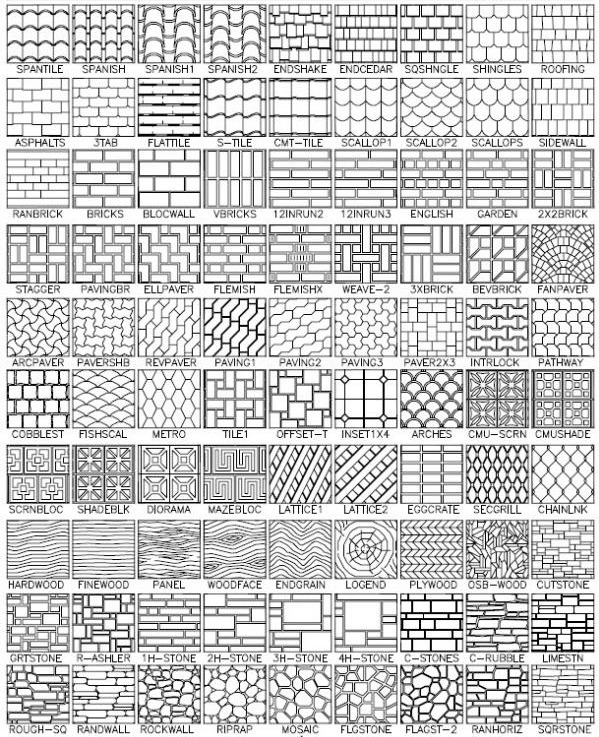
Ashlar Hatch Pattern Autocad Blocks Library
DesignCAD 3D MAX is an easy-to-use, versatile CAD tool that's perfect for novice designers, but powerful enough to create high-quality 2D/3D designs, models and animations. The intuitive interface and extensive online help make it easy to get started. Get a complete set of 2D design tools with drawing layers, hatch patterns, and full dimensioning capability.
While AutoCAD comes with a large variety of hatch patterns, you can also create your own. This feature has been around for many years. Hatch patterns are stored in files with a file extension of.pat. You can add your hatch to the default acad.pat or create your own.pat file.
As always, don’t forget to make a copy of acad.pat or acadlt.pat before you edit it. If you create your own.pat file, here are some points to remember: • If you aren’t adding patterns to acad.pat or acadlt.pat, you can put only one hatch pattern in a custom.pat file; the filename and pattern name must be the same • You can insert comments in your.pat file after a semicolon • You must press Enter after the end of the last line of the hatch definition Note: To find the location of acad.pat or acadlt.pat, right-click the drawing area and choose Options; then click the Files tab. Double-click the Support File Search Path item to display the location of the support files. The syntax for hatch patterns is as follows: *pattern-name[, description] angle, x-origin,y-origin, delta-x,delta-y [, dash1, dash2, ] Hatch-pattern definitions have a few rules: • The description is optional; if you include one, precede it with a comma. • Add the dash specifications only for noncontinuous lines. Serial number garritan personal orchestra 5 torrent. • You can have more than one definition line (the second line in the syntax I just showed), creating sets of hatch definitions that combine to create the hatch pattern. • Each definition line can be no more than 80 characters.
• You can include a maximum of six dash specifications (which include spaces and dots). • You can add spaces in the definition lines for readability. This following explains the meaning of the terms in the definition: • Angle: Defines the angle of the lines in the hatch pattern.
If you also specify an angle in the Boundary Hatch and Gradient dialog box when you place the hatch, AutoCAD adds the two angles. • X-origin: Specifies the X coordinate of the base point of the hatch pattern. Your hatch probably won’t go through 0,0; however, this point lines up sets of lines in hatch patterns, as well as aligning hatch patterns in different areas. Because all hatch patterns are calculated from the base point, they’re always aligned, no matter where they actually appear in the drawing.
• Y-origin: Specifies the Y coordinate of the base point of the hatch pattern. • Delta-x: Specifies the offset of successive lines. This applies only to dashed lines and is measured along the direction of the lines.
Specifying a delta-x staggers each successive line by the amount that you specify so that the dashes don’t line up. • Delta-y: Specifies the distance between lines, measured perpendicular to the direction of the lines. This applies to both continuous and dashed lines. • Dash: Defines a noncontinuous line using the same system as linetype definitions: positive for a dash, negative for a space, and 0 for a dot. Let’s look at a couple of examples. *ftrailer, proposed future trailers 105, 0,0, 0,0.5,.5,–.25,0,–.1,0,–.25 This hatch has an angle of 105 degrees, an origin of 0,0, a delta-x of 0, a delta-y of 0.5 (the spacing between lines), and then defines a non-continuous linetype (dash, space, dot,space,dot,space). Here’s a more complex example: *trail, whole trailers-proposed 0, 0,0, 0,2,.5,–1 90, 0,0, 0,1.5,.5,–.25,0,–.25.5,–.5 90,.5,0, 0,1.5,.5,–.25,0,–.25.5,–.5 0, 0,1.5, 0,2,.5,–1 This hatch pattern has 4 lines.
Two are at 0 degrees, and two are at 90 degrees. This creates the rectangular shape. The difference between the two lines that start at 0 degrees is their origin. The second one starts at 0,1.5. The 90-degree lines also have different origins. The linetype for the 90-degree lines is dash, space, dot, space, dash, space. John, in theory any herringbone should be able to be duplicated with one horizontal family of lines, and one vertical.
Autocom CDP 2013.R1 FULL Obd Auto Doctor Keygen Serial Numbers. Convert Obd Auto Doctor Keygen trail version to full software. Powerdyn obd 1.6 Powerdyn obd ver 1.4.1 Powerdyn obd 1.41 download Powerdyn 1.41 download Powerdyn 141 Obd torque for pc. Braking Distances Fuel Consumption. OBD ELM327 Software torrent. Powerdyn obd 16 keygen download. Powerdyn Obd 1.6.2 Serial Numbers. Convert Powerdyn Obd 1.6.2 trail version to full software. Page links for easy keygen and crack navigation: Use these letter links to locate any crak with serial number to unlock software using keygens and cracks! PowerDyn.OBD.1.3.0 SERIAL-FFF can be used for unlocking (cracking) too.
In practice, I don’t think it works. But first, I hope I’m right in assuming you’re talking about each rectangle/paver being 1.75 units x 8 units? If so, then my belief is it’s not your fault – it’s that the pattern doesn’t repeat itself for a very long time. To use only two line definitions we need to have a very large “off” distance (9.75 ON, then 102.25 OFF), and having experimented, I believe Autocad chokes on this – for some reason I’ve never understood it often struggles to “cut” a dashed line unless the line happens to have an “on” bit nearby, so this particular hatch you’re wanting is a worst-case scenario. If you can handle nudging your proportions into a shape where the smaller side divides more neatly into the larger (eg 2 units x 8 units), then the lines will repeat/align much sooner in the pattern and it should work for you.